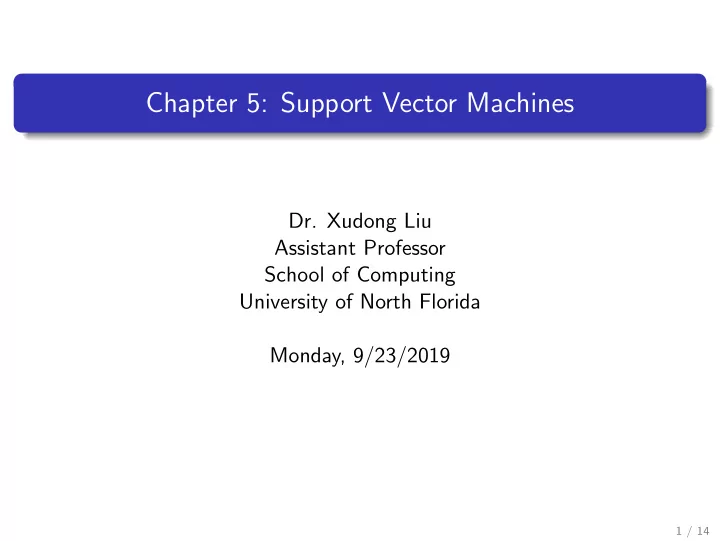

Chapter 5: Support Vector Machines Dr. Xudong Liu Assistant Professor School of Computing University of North Florida Monday, 9/23/2019 1 / 14
Support Vector Machines Linear SVM classification: hard margin, soft margin Nonlinear SVM classification: polynomial features, similarity features Under the hood: decision function, objective functions Overview 2 / 14
Linear Support Vector Machines A linear SVM classifier fits the “widest possible street” between the classes. The solid line in the right image represents the decision boundary of this SVM. It not only separates the two classes, but also stays as far away from the closest training example as possible. The decision boundary is determined or supported by the examples located on the edge of the street. These examples are called “support vectors.” Linear SVM 3 / 14
Sensitivity to Feature Scales Linear SVM 4 / 14
Hard Margin Classification Hard margin classification: if we impose that all examples must be off the street and on the correct side. Problems: only works for linear separable, and is sensitive to outliers. Linear SVM 5 / 14
Soft Margin Classification To be more flexible, soft margin classification tries to balance between margin size (keep the street as wide as possible) and margin violations (keep the number of examples in the street or even on the wrong side as small as possible). Scikit-Learn: LinearSVC provides a hyperparameter called C . The smaller it is, the wider the street with more violations. Reducing C can help with overfitting. Linear SVM 6 / 14
Nonlinear Support Vector Machines Many datasets are not even close to being linearly separable. By adding features we can add extra features to the dataset to make it linear separable. One feature x 1 alone is not separable. Adding feature x 2 = x 2 1 makes the dataset separable. Nonlinear SVM 7 / 14
Polynomial Features Nonlinear SVM 8 / 14
Similarity Features Similarity features measure how much each training example resembles a particular landmark. Gaussian Radial Basis Function: φ γ ( x , l ) = exp( − γ || x − l || 2 ). Nonlinear SVM 9 / 14
Gaussian Radial Basis Function Hyperparameter γ : the bigger, the decision boundary becomes more irregular, more wiggling around the examples. If overfitting, try reduce γ , and C as well. Nonlinear SVM 10 / 14
Computational Complexity When the dataset is very large and has many features, try Linear SVM. It dataset is not very large, try SVC’s Guassian RBF which tends to work better than Linear SVM. Nonlinear SVM 11 / 14
Linear Support Vector Machines Linear SVM classifier predicts the class of a new instance x by computing the decision function : w T · x + b = w 1 x 1 + . . . + w n x n + b . Then, if the result is negative, the prediction is the negative class; otherwise, the positive class. Under the Hood 12 / 14
Linear Support Vector Machines Under the Hood 13 / 14
Objective Function in Hard Margin Linear SVM Learning Because the smaller the || w || , the wider the street, we want to minimize it. At the same time, we want to avoid margin violations, then we want the decision function to be greater than 1 for positive examples and smaller than -1 for negative examples. Thus, the following objective function: 2 w T · w 1 minimize w , b subject to t ( i ) ( w T · x ( i ) + b ) ≥ 1 for i = 1 , . . . , m Under the Hood 14 / 14
Recommend
More recommend